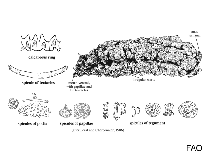Isostichopus macroparentheses (Clark, 1922)
Warning: DOMDocument::load(): SSL operation failed with code 1. OpenSSL Error messages: error:140770FC:SSL routines:SSL23_GET_SERVER_HELLO:unknown protocol in C:\Apache24\htdocs\includes\SpeciesSummary.lib.php on line 1236
Warning: DOMDocument::load(): Failed to enable crypto in C:\Apache24\htdocs\includes\SpeciesSummary.lib.php on line 1236
Warning: DOMDocument::load(https://sealifebase.nrm.se/webservice/AquaMaps/getAMap.php?genus=Isostichopus&species=macroparentheses): failed to open stream: operation failed in C:\Apache24\htdocs\includes\SpeciesSummary.lib.php on line 1236
Warning: DOMDocument::load(): I/O warning : failed to load external entity "https://sealifebase.nrm.se/webservice/AquaMaps/getAMap.php?genus=Isostichopus&species=macroparentheses" in C:\Apache24\htdocs\includes\SpeciesSummary.lib.php on line 1236
Upload your photos
Google image | No image available for this species;
drawing shows typical species in Stichopodidae.
Google image | No image available for this species;
drawing shows typical species in Stichopodidae.
Classification / Names Common names | Synonyms | CoL | ITIS | WoRMS
Holothuroidea | Synallactida | Stichopodidae
Environment: milieu / climate zone / depth range / distribution range Ecology
Benthic; depth range 0 - 18 m (Ref. 94441). Tropical
Distribution Countries | FAO areas | Ecosystems | Occurrences | Introductions
Western Central Atlantic: Caribbean.
Length at first maturity / Size / Weight / Age
Maturity: Lm ? range ? - ? cm Max length : 12.0 cm TL male/unsexed; (Ref. 86832)
Life cycle and mating behavior Maturity | Reproduction | Spawning | Eggs | Fecundity | Larvae
Members of the class Holothuroidea are gonochoric and have only one gonad. Spawning and fertilization are both external and some exhibit brooding. Life cycle: Embryos develop into planktotrophic larvae (auricularia) then into doliolaria (barrel-shaped stage) which later metamorphose into juvenile sea cucumbers.
Main reference
References | Coordinator | Collaborators
Hendler, G. and D.L. Pawson. 2000. (Ref. 86570)
IUCN Red List Status (Ref. 130435)
Data deficient (DD) ; Date assessed: 20 August 2011
CITES status (Ref. 108899)
Not Evaluated
CMS (Ref. 116361)
Not Evaluated
Threat to humans
Harmless
Human uses
| FishSource |
Tools
More information
Age/Size
Growth
Length-weight
Length-length
Morphology
Larvae
Abundance
Growth
Length-weight
Length-length
Morphology
Larvae
Abundance
Internet sources
BHL | BOLD Systems | CISTI | DiscoverLife | FAO(Publication : search) | Fishipedia | GenBank (genome, nucleotide) | GloBI | Gomexsi | Google Books | Google Scholar | Google | PubMed | Tree of Life | Wikipedia (Go, Search) | Zoological Record
Estimates based on models
Preferred temperature
(Ref. 115969): 26.1 - 28.3, mean 27.4 (based on 292 cells).



